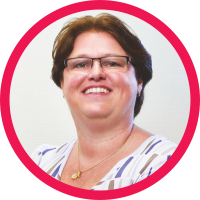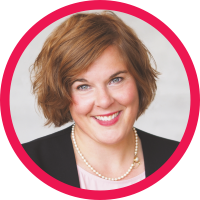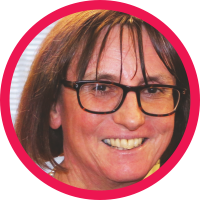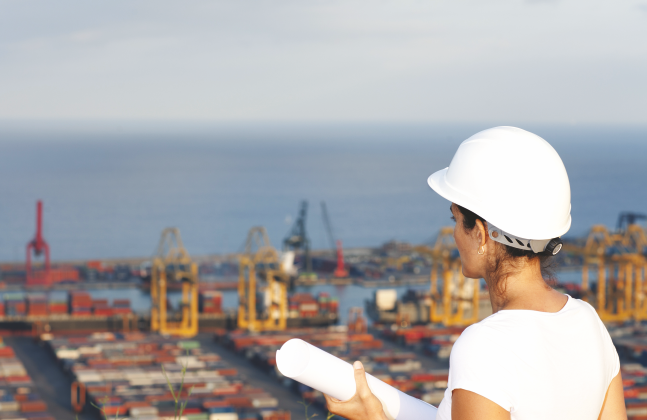Maritime SheEO focuses on the business case for diversity. It aims to create solutions that can impact the entire maritime industry with a focus on diversity and inclusion (D&I), leadership, innovation, entrepreneurship and competitive advantage.
Women currently make up just 2 per cent of the global maritime workforce (according to figures from the International Transport Workers’ Federation), so it’s fair to say there is room for improvement. The year 2019 (hopefully) can be marked as a turning point for women in the maritime industry. A major testimony to this is the International Maritime Organization’s (IMO) decision to make ‘Empowering Women in the Maritime Community’ as the theme for World Maritime Day. It has been reported that the recruitment of women in both junior and senior roles within shipping companies is on the rise, with maritime organisations increasingly promoting the benefits of a gender-balanced workforce.
Sanjam Sahi Gupta, Founder, Maritime SheEO and a major crusader for the cause of gender diversity says, “Diversity isn’t just the right thing to do, it is profitable. In an increasingly competitive industry being disrupted, we need increased level of diversity to innovate and to continue to create value.” In fact, the leadership accelerator programme for women in the maritime and logistics sector – Maritime SheEO works with employers to create an environment conducive for women to rise to leadership positions.
Maritime SheEO focuses on the business case for diversity. It aims to create solutions that can impact the entire maritime industry with a focus on diversity and inclusion (D&I), leadership, innovation, entrepreneurship and competitive advantage. It employs D&I initiatives to address and eliminate unconscious bias, uses gender sensitisation techniques throughout the programme and enables the smooth transition of women from ship to shore operations.
“The debut Maritime SheEO Conference will be organised on March 20,2020 in Mumbai. The event will honour companies that are champions in advancing diversity and fostering a culture of inclusion within their workforce. Maritime SheEO intends to showcase and recognize best practices from companies. Award winners have the opportunity to share their best practices that are developing and delivering diversity and inclusion initiatives with demonstrable success, via Maritime SheEO social media and promotional campaign prior, during and post the conference.”
Maritime Gateway has reached out to some of the prominent women in the maritime sector to know what it takes to promote gender diversity in this sector.

Karin Orsel, CEO, MF Shipping Group, has been promoting diversity in this male dominated industry for the past three decades. She says, “Throughout 2019 there has been a strong emphasis within the maritime industry on the importance and added value of women working within the industry in various roles both ashore as well as on board vessels which has my full support. Since the beginning of my career I see it as my personal mission to attract and support more women entering our industry to promote gender equality within the industry and within my own company. Gender equality, diversity and inclusiveness are key in providing a sustainable future for the global maritime industry. I know from experience that having an inclusive culture in your workplace boosts moral and opportunity. Making a difference starts by stepping up and contributing to a change for a better future for all of us. Every contribution how big or small counts!”
Karin Orsel began working in the shipping industry when she was 18. When she was 23 she had a choice, either to join another company or to start her own business. Despite having no entrepreneurs in the family, no family history in the maritime industry and zero capital she decided to go for it. She became a Financial Manager and shareholder and started the business with 3 people at the office, 6 small dry cargo vessels under crew and financial management and 50 seafarers. Today, 25 years later the company manages and partly owns 55 dry cargo, cement carriers and chemical tankers and employ’s approximately – 1000 seafarers.

“Women in Shipping may not primarily be taking over in the engine rooms, or in the crane cockpits. I think they will enter into roles that shipping hasn’t had too much of thus far. Fintech, healthtech, ecosystem, renewables, venture, collaboration, sustainability, etc. This is where you will find your next SheEO,” informs Sofia Fürstenberg Stott, Owner & Chief Advisor, Fürstenberg Maritime Advisory
Q In spite of the rising awareness about gender discrimination, why many people struggle to break that metaphorical glass ceiling?
Rising awareness is just a starting point. While gender discrimination has many layers and levels, it is not the serious offences of discrimination that create the main barriers for career advancement – it is the underlying culture, the habits, and the system upholding an organisation. It might even be the smallest thing – such as having a company management system referring to people as “he”. Women and men alike, still prefer to see a man in certain leadership roles, even though they would perhaps never admit it. Women who aspire for these positions may struggle with having sufficient confidence to reach for these roles, as they tend to compare themselves with the men who went before them. Having female role models are extremely important, not only for the aspiring women, but for the entire organisation.
Q How can organisations improve the work environment for the disadvantaged gender both at the time of hiring and during employment?
I don’t like to use the term “disadvantaged gender”, as this is not how I see the situation. It is a disadvantaged company who is missing out on talent and opportunity for strengthening its business when it is not able to attract and retain the right person for the job. The way to improve is to take a hard look on its internal systems and working culture, and work with identifying and changing biases, known and unknown, and develop a strategic action plan to work with these issues focused and attentively. There is no quick fix.
Q How can women break the invisible barriers and rise up in career to become SheEOs?
There are many ways to reach the top, and some options are more gentlewomanlike than other. You can reach the top by exploiting your colleagues, by grabbing opportunities in front of others, by being strategically egoistic and hard. This is not my way. I would first ask myself the question “Why do I want to lead a company?” What values are important to you, what kind of impact would you like to have, what are the qualities and aspirations you can bring to a company, for its staff, customers, stakeholders and society? Why should it be you? When you have arrived at answers for these questions, then lay a plan, looking 3-5 years ahead. What capabilities and competencies do you need to acquire, in order to get going on that path? How do you need to develop as a leader? Are you intending to rise inside the company you are currently at, or are you a self-starter, would you like to have your own company? Then look for mentors. Look really hard for them, and be very specific with what you want to talk about with such a mentor. Have a strategy with everything you do, value your time. And prioritise time with family and friends, because they are important if you are to become an authentic leader in the future.
Q In your opinion what are three typical challenges that women 40 MARITIME GATEWAY | FEBRUARY 2020 employees in Shipping & Logistics sector face in their career?
Some of us came to this industry by chance, still as a woman, in my experience you always need to have a good answer prepared as to why you are here. Women tend to choose softer subjects than men for their education, this is a scientific fact. I am an engineer myself, and when I was a student, chemical engineering was the only branch which had 50% spread women/men alike, all other branches had far less participation from women. Independent of what education you have however, life is mysterious, and you may well end up in the Shipping & Logistics sector – because your specific knowledge and competences are needed! This is where I currently see a conundrum in this industry; the industry is entering a new decade expected to bring about unprecedented change, with opportunities for new business, great challenges to solve and the threat of disruption from new actors entering the industry from another angle. This will require all hands on deck, and a whole plethora of new competences need to come onboard, and there will be increasing demands for new thinking with regards to leadership. I think many of the change makers for shipping in the future will be young, and they will be women. But we mustn’t allow stubborn company cultures and gender-bias organisational structures take the edge off this talent. Because Shipping can’t afford it. Women in Shipping may not primarily be taking over in the engine rooms, or in the crane cockpits. I think they will enter into roles that Shipping hasn’t had too much of thus far. Fintech, Healthtech, Ecosystem, Renewables, Venture, Collaboration, Sustainability, etc.. This is where you will find your next SheEO.
Sofia Fürstenberg Stott is a popular speaker/moderator and a leading figure in the innovation- and sustainability sphere of the maritime industry. Launching her own advisory at the beginning of 2017, focusing on the transformational journey towards decarbonisation, she has developed Nor-Shipping’s new concept exhibition Blue Economy, and launched the first Opening Oceans Conference, connecting the wider ocean industries for the first time. She has been a visible figure in the Nordics for over a decade, through her tenure as Innovation Portfolio Manager with Maersk, and as a green shipping spearhead with DNVGL. She holds an MBA in Shipping & Logistics from Copenhagen Business School, an MSc in Chemical Engineering from Lund University, and was part of the first cohort to finish the Top Tech Executive Innovation Program at Haas Business School back in 2009.

“The lack of women in maritime leadership roles holds back not only women, but all people, and the sooner this is addressed the sooner we will be able to advance,” avers, Bridget Hogan, Director of Publishing and Membership, The Nautical Institute
Issues in breaking that metaphorical glass ceiling
Obviously there are many reasons – some to do with the qualifications or experience companies demand, some to do with attitudes of potential employers and some to do with acceptance of the particular circumstances women face – such career breaks. In addition there are the hundreds, if not thousands, of little slights and remarks that women have to contend with every day which eat away at their confidence. Lack of confidence is an invisible enemy which is why I will be addressing mentoring at the Maritime SheEO conference. Sometimes it is easier to face the big issue – even if the problem cannot be solved – as it is much easier to articulate that. But the countless attacks and bullying that many women have to contend with constantly eat away at people.
Improving the work environment for women
There are many simple ways and the good news is that if employers do improve the work environment all benefit. Increasingly men are seeking flexible working and career breaks as they do not wish to miss out on their families either. One simple fix is to examine the language of advertisements. It has been shown that it is not only females who can be discouraged from applying for posts if the language used to describe the post is macho. Young men can be too. And if there’s another problem that the maritime industry has to address that is the age discrepancy. It is an aging industry. A survey of Fortune 500 companies shows that companies with diverse leadership innovate more, review information more carefully, and make fewer mistakes.
This was illustrated by Twitter’s cofounder Ev Williams he said a more diverse leadership team would have spotted the platform’s evasive harassment from the beginning. “Had I been more aware of how people not like me were being treated and/ or had I had a more diverse leadership team or board, we may have made it a priority sooner,” he wrote on Twitter.
How can women break the invisible barriers and rise up in career to become SheEOs?
It is complex and there is nothing to beat determination and a thick skin! Having a mentor who can help to turn things positive during bad times can definitely help. Women must be assertive and not be typecast to handling only ‘women’s work’ – whatever that might be. Choose your employer. Sexual harassment is very real and it may force women to turn down a high paying position on a career path to a lowlier post. Speak up and talk out. Let people know what you’re paid and find out what they are paid. Women must understand that the glass ceiling is no reflection of their value as a person or as an employee. Glass ceilings ensure that even if a person has positioned themselves to meet every demand of a role, they will still be denied the opportunity. Even those with key competencies and self-confidence required for the upper levels are still denied advancement. It’s not easy but here’s how things can start to change. Bring the issue out into the open which may mean having some difficult conversations. Do senior managers fear losing out themselves if the organisation becomes more inclusive? Do they worry that it will affect performance?
See where open conversations about these issues lead. There may be a backlash, but this could be countered by emphasising that change needn’t be threatening. It should simply allow those who deserve opportunities to access them, regardless of gender, race, or any other factor. Ask team members for their views. Others may have good suggestions for improvement. Try to encourage organisations to recognise and challenge bias. And did I mention? Get help from a mentor – who may or may not be part of our organisation.
Three typical challenges that women face
There is a lot of unconscious bias and even conscious bias in the industry. This is best illustrated by the instance for a lot of posts that candidates have seafaring experience – even if it isn’t central to the job. Fewer than 2% of seafarers are thought to be female so it narrows the potential for those applying for the job from the start. I have heard of board room decision where female candidates have been considered the best but passed over for males because it is considered the organisation has ‘enough’ senior females – probably a token one.
The lack of female role models in some areas doesn’t help. The lack of women in maritime leadership roles holds back not only women, but all people, and the sooner this is addressed the sooner we will be able to advance. Women should take advantage of the support organisations such as WISTA offer. There is always someone to help and many have had similar experiences.
Lack of sponsorship of women in the workplace by maritime leaders. Of course there are great examples, but there are many places in the world where maritime leaders do not speak up for women.
Bridget Hogan is Director of Publishing and Membership of The Nautical Institute, where she is responsible for the Institute’s 100 plus books and magazines and its membership. She has been involved with the publishing industry for over 45 years and has worked in the maritime industry in various roles for more than 40 years. After starting in newspapers, Bridget moved to industrial reporting, first in the motor industry, then ports and finally shipping. She was appointed a News Editor at 21 and then moved to Lloyd’s List as its senior shipping writer. From there she moved to the shipping industry.

“It is in the best interest of organisations to have a diverse workforce, because it has been proven that this will bring better results for them. It is very important to spread awareness around the topic; this itself will help a lot,” Suggests Cristina Saenz de Santa Maria, Regional Manager, South East Asia Pacific & India, DNV GL
Issues in breaking that metaphorical glass ceiling I believe that the level of awareness has raised a lot during the last few years. However this is not a quick fix problem, so it will take some time until we reach the point of more balanced and diverse workforce. That diversity is important in terms of gender but also other dimensions like age, culture etc. I am lucky to work for DNV GL that gives equal opportunity to both genders. It is important that efforts are put since school and university to inspire girls choose a technical path.
Improving the work environment for women
I believe in giving same opportunities and focusing on always hiring and giving chances to the best candidate. It is in the best interest of organisations to have a diverse workforce, because it has been proven that this will bring better results for them. It is very important to spread awareness around the topic; this itself will help a lot.
How can women break the invisible barriers and rise up in career to become SheEOs?
I would say by not being shy, share and talk about their ideas. Also to not shy away from thinking that they might not be prepared for a certain role. It is important to see the potential, and maybe you are only 80 per cent qualified for that job, but go for it and you will learn the rest at work.
Three typical challenges that women face
I would say 1) Maybe ourselves: we are sometimes too shy and too humble, 2) its proven that people hire and feel more comfortable surrounded by other people that are similar to them; and this puts women in a disadvantaged position sometimes in places where there are not that many women in teams; 3) balance work and family life – specially with kids at young ages.
Cristina Saenz de Santa Maria is responsible for DNV GL’s maritime operations in South East Asia Pacific & India in her capacity as Regional Manager. Having joined DNV in 2005, she has worked in newbuilding and operations phases as a ships surveyor and project manager in Spain, Portugal, South Korea and Norway. After heading the ships in operations section in head office, in 2012 she took the position of professional assistant to the CEO for maritime and oil & gas. Since the merger with GL in September 2013, she worked at DNV GL Group as senior consultant to the CEO’s office and was project manager for the merger.

“Women should learn about the unconscious bias and how to deal with it, find sponsorship and mentors, be part of associations that facilitate the network like WISTA, understand the rules of the money and have a technological mind set, opines Fabiana Simões Martins, Manager Partner, SMA Legal
Issues in breaking that metaphorical glass ceiling
Unfortunately information and awareness are not been enough to move our society to action. If you see the Global Gender Gap report 2020 from the World Economic Forum you will note that female economic participation and opportunity have regressed forcing gender parity to a lowly 57.8%, which in time represents a massive 257 years before gender parity can be achieved.
The report highlights three primary reasons for this: women have greater representation in roles that are being automated; not enough women are entering professions where wage growth is the most pronounced (most obviously, but not exclusively, technology), and women face the perennial problem of insufficient care infrastructure and access to capital.
In terms of economic participation, the gender gap will take 257 years to close (compared to 202 years in the 2019 report). Globally, only 55% of women (aged 15-64) are engaged in the labour market as opposed to 78% of men. There are 72 countries where women are barred from opening bank accounts or obtaining credit.
There is no country where men spend the same amount of time on unpaid work as women. In countries where the ratio is lowest, it is still 2:1. In my experience and view the two first reasons highlighted by the Report are also influenced by the third: access to capital. From access to capital I mean not only money and credit but also sponsorship and referral. To give you a personal and recent example, during the festivities of the New Year my business partner made new male friends and in the end of the holidays they told him: “We really liked to meet you, let´s introduce you to X, Y, W, they are the biggest entrepreneurs in Brazil and you should make business together.” How many times do you see people giving this kind of referral to women? I am in the business for 23 years and have to say that if you are not focused and committed with gender equality this does not happen to women and if we do not give business, referral, jobs and financial credit to women, but only to men, nothing is going to change.

“IMO is huge excited to work with Maritime SheEO to promote the next generation of Maritime leaders. Keep inspiring us Sanjam.”
– Helen Buni
Principal Programme Assistant, Technical Cooperation Division, IMO
Improving the work environment for women
There are many HR agencies specialized in diversity with different methods and data basis and companies should start demanding this knowledge to their HR departments. If your team has less than 30 per cent of women in management levels, there is something wrong with recruiting and retention. There is no magic, as an entrepreneur or CEO you need to build your team based on the value of diversity what means to hire the best talents you can find among male and female but if you do not focus in having at least 30 per cent of women this is not likely to happen spontaneously and you will finish the day with an only male or 90 per cent male team because this is how our unconscious bias makes us select a team specially in countries with low gender equality.
If I had a dollar for every time someone comes to me and says there is no woman for the position I would be a billionaire and only in WISTA we have +3000 women in 50 different countries. Nowadays with LinkedIn it does not take me more than 15 seconds to find female professionals with excellent backgrounds but the truth is that you do not see what you do not want to see and women are still invisible for many people in the industry. To give you another personal example I have seen people in Law Firms hiring a male professional to have the job done by the female that works for him but they have never hired the female professional directly. This needs to change.
With regard to improving the environment during employment you need to have anti-bullying and antiharassment policies in place making sure your team knows that you are compromised with gender equality and again guarantee that you have at least 30 per cent of women in all levels, since one woman alone cannot change the male dominated culture. It is common for example that male professionals have more budget for marketing and less pro bono work in companies, if it is your case you are sending a message to the female professionals that they will not grow in your company and they may look for another place to have better opportunities. We need to remember that people do not leave companies they leave bad bosses.
How can women break the invisible barriers and rise up in career to become SheEOs?
It is not a job for women alone, this is something that all the society, men and women need to do together. Of course that in private level there are things that women can do like learn about the unconscious bias and how to deal with it, find sponsorship and mentors, be part of associations that facilitate the network like WISTA, understand the rules of the money and have a technological mind set.
However the invisible barriers will only be broken when all the society with women and specially men work together. Thankfully in the last years I found many men that already understood that it is impossible to achieve more economic and sustainable growth without 50 per cent of our population and are together with us promoting gender equality in business.
Three typical challenges that women face
Lack of sponsorship, referrals and invisibility.
Fabiana Simões Martins is for 23 years the manager partner of SMA, a Firm ranked in the first band among Brazilian Shipping Law Firms by Chambers & Partners. Fabiana is also the founder President of WISTA Brazil, the former vice President of the Ibero American Maritime Law Institute and actual board member of Women’s International Shipping and Trading Association, an organization comprised of 46 National WISTA Associations and more than 3000 individuals. She holds a master degree in International Law and is well known by the shipping industry for assisting prominent ship owners and P&I clubs with litigation and arbitration cases arising from shipping accidents and cargo claims.








